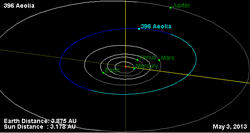Astronomy:396 Aeolia
 Orbital diagram | |
| Discovery | |
|---|---|
| Discovered by | Auguste Charlois |
| Discovery date | 1 December 1894 |
| Designations | |
| (396) Aeolia | |
| Pronunciation | /iːˈoʊliə/[1][2] |
| Named after | Aeolis |
| 1894 BL | |
| Minor planet category | Main belt (Aeolia clump) |
| Orbital characteristics[3] | |
| Epoch 31 July 2016 (JD 2457600.5) | |
| Uncertainty parameter 0 | |
| Observation arc | 89.89 yr (32,831 d) |
| |{{{apsis}}}|helion}} | 3.17927 astronomical unit|AU (475.612 Gm) |
| |{{{apsis}}}|helion}} | 2.30468 AU (344.775 Gm) |
| 2.74198 AU (410.194 Gm) | |
| Eccentricity | 0.15948 |
| Orbital period | 4.54 yr (1,658.4 d) |
| Mean anomaly | 81.8407° |
| Mean motion | 0° 13m 1.466s / day |
| Inclination | 2.54990° |
| Longitude of ascending node | 249.930° |
| 21.8317° | |
| Physical characteristics | |
| Dimensions | 34.09±3.2 km |
| Rotation period | 14.353 h (0.60 d)[4] |
| Geometric albedo | 0.1667±0.036 |
| Absolute magnitude (H) | 10.0 |
Aeolia (minor planet designation: 396 Aeolia) is a typical main belt asteroid. It was discovered by the French astronomer Auguste Charlois on 1 December 1894 from Nice, and may have been named for the ancient land of Aeolis.[5] The asteroid is orbiting the Sun at a distance of 2.74 astronomical unit|AU with a period of 4.54 years and an eccentricity (ovalness) of 0.16. The orbital plane is inclined at an angle of 2.5° to the plane of the ecliptic.[3] This is the largest member of the eponymously named Aeolia asteroid family, a small group of asteroids with similar orbits that have an estimated age of less than 100 million years.[6]
Analysis of the asteroid light curve based on photometry data collected during 2016 show a rotation period of 14.353±0.001 h with a brightness variation of 0.36±0.02 in magnitude. This rules out a previous estimate of 22.2 hours.[4] It is a metallic Xe type asteroid in the SMASS classification.[6]
References
- ↑ Noah Webster (1884) A Practical Dictionary of the English Language
- ↑ Aeolian (3rd ed.), Oxford University Press, September 2005, http://oed.com/search?searchType=dictionary&q=Aeolian (Subscription or UK public library membership required.)
- ↑ 3.0 3.1 "396 Aeolia (1894 BL)". JPL Small-Body Database. NASA/Jet Propulsion Laboratory. https://ssd.jpl.nasa.gov/sbdb.cgi?sstr=396.
- ↑ 4.0 4.1 Pilcher, Frederick (April 2017), "Rotation Period Determination for 396 Aeolia, 298 Admete, 422 Berolina, and 555 Norma", Bulletin of the Minor Planets Section of the Association of Lunar and Planetary Observers 44 (2): 112–114, Bibcode: 2017MPBu...44..112P.
- ↑ Schmadel, Lutz (2003), Dictionary of minor planet names, 1, Springer, p. 47, ISBN 9783540002383, https://books.google.com/books?id=VoJ5nUyIzCsC&pg=PA47.
- ↑ 6.0 6.1 Spoto, Federica et al. (September 2015), "Asteroid family ages", Icarus 257: 275–289, doi:10.1016/j.icarus.2015.04.041, Bibcode: 2015Icar..257..275S.
External links
- 396 Aeolia at AstDyS-2, Asteroids—Dynamic Site
- 396 Aeolia at the JPL Small-Body Database
 |

